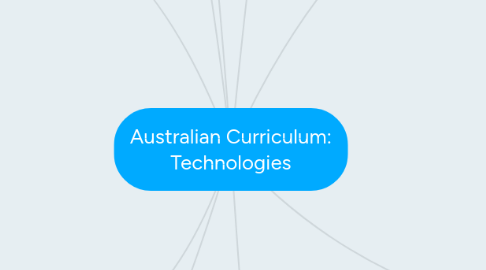
1. Purpose
1.1. Enable students to learn about and work with traditional, contemporary and emerging technologies that shape the world we live in
2. Digital Technologies
2.1. Knowledge and Understanding
2.1.1. how data are represented and structured symbolically
2.1.2. the components of digital systems: software, hardware and networks
2.1.3. the use, development and impact of information systems in people's lives
2.2. Processes and Production Skills
2.2.1. collecting, managing and interpreting data when collecting information, and the nature and properties of data, how it is collected and interpreted
2.2.2. Using a range of digital systems and their components and peripherals
2.2.3. defining problems and specifying and implementing their solutions
2.2.4. Creating and communicating information, especially online, and interacting safely using appropriate technical and social protocols
3. Key Ideas
3.1. Systems thinking and creating preferred futures
3.1.1. Provide opportunities for students to apply practical skills and processes when using technologies to create innovative solutions that meet current and future needs
3.1.2. Students consider creating preferred futures as they work through technologies processes and production
3.1.3. Students will apply computational, design and systems thinking and consider ethical, economic, environmental and social sustainability factors when they design and produce solutions to problems
3.1.4. Students will predict outcomes and impacts of technological decisions for current and future generations and consider probable futures
3.2. Project Management
3.2.1. Students are explicitly taught how to manage projects and apply this knowledge in their projects.
4. Aim
4.1. To develop the knowledge, understanding and skills so that students:
4.1.1. Are creative when using technologies and understanding how they have developed over time
4.1.2. Choose and use appropriate technologies when designing solutions
4.1.3. Evaluate technologies processes to find solutions to problems
4.1.4. Create technologies solutions
4.1.5. Engage with technologies to make decisions about technologies for preferred futures
5. Band Levels
5.1. Foundation to Year 2
5.2. Year 3 and 4
5.3. Year 5 and 6
5.4. Year 7 and 8
5.5. Year 9 and 10
5.6. Expectations of Curriculum
5.6.1. Students F-Year 8 will study Technologies
5.6.2. Year 9+ students and schools will have the option to continue
6. Organisation
6.1. Content Descriptions
6.1.1. Descriptions at each band level
6.1.2. Describe the knowledge, understudying and skills that teachers teach, and students learn
6.2. Content Elaborations
6.2.1. Support material to illustrate and exemplify what is to be taught to assist teachers
6.3. Achievement Standards
6.3.1. Indicate the quality of learning that students should demonstrate
6.3.2. Describes students progress through each band level
6.3.3. Gives teachers framework for development and growth
7. Design and Technology
7.1. Knowledge and Understanding
7.1.1. the use, development and impact of technologies in people's lives
7.1.2. design concepts across a range of technologies contexts
7.2. Processes and Productional Skills
7.2.1. Critiquing, exploring and investigating needs or opportunities
7.2.2. Generating, developing and evaluating design ideas for designing solutions
7.2.3. Planning, producing and evaluating designed solutions
8. Rationale: Why study Technologies?
8.1. Technologies enrich and impact people and society, globally
8.2. Australia needs enterprising individuals who can
8.2.1. make decisions about the development and use of technologies
8.2.2. independently and collaboratively develop innovative solutions to complex problems
8.2.3. contribute to sustainable living
8.3. Technologies transform, restore and sustain our societies and environments
8.4. Provides new ways of thinking, collaborating and communicating
8.5. Students progress through play, knowledge, understanding and skills.
8.6. Students can apply practical skills and processes when using technologies and resources to create solutions to meet current and future needs
8.7. All Australians should develop capacity for action and appreciation of technology- how it is developed and how they contribute to society
8.8. Through school they will shape and challenge attitudes to the use and impact of technologies by evaluating their own and others solutions.
9. Subjects
9.1. Design and Technology
9.1.1. Knowledge and Understanding
9.1.1.1. Technologies and society
9.1.1.2. Technologies contexts
9.1.1.3. Materials and technologies specialisations
9.1.1.4. Food and fibre production
9.1.1.5. Engineering principles and systems
9.1.1.6. Food technologies
9.1.2. Processes and Production Skills
9.1.2.1. Critiquing, exploring and investigating
9.1.2.2. Generating, developing and evaluating ideas
9.1.2.3. Planning, producing and evaluating designed solutions
9.2. Digital Technologies
9.2.1. Knowledge and Understanding
9.2.1.1. Representation of data
9.2.1.2. Digital systems
9.2.1.3. Interaction and impact
9.2.2. Processes and Production Skills
9.2.2.1. Managing and analysing data
9.2.2.2. Using digital systems
9.2.2.3. Specification, algorithms and implementation
9.2.2.4. Creating and intreating online
10. Strands
11. Student Diversity
11.1. Teachers take account of the range of students' levels of learning, strengths, goals and interests and make adjustments where necessary
11.1.1. Students with disability
11.1.2. English as an additional language or dialect
11.1.3. Gifted and talented students
11.2. Flexibility to cater for diverse needs comes from the design of the AC
11.2.1. Learning areas
11.2.1.1. Design and Technology
11.2.1.2. Digital Technologies
11.2.2. general capabilities
11.2.2.1. Literacy
11.2.2.2. Numeracy
11.2.2.3. Information and communication technology
11.2.2.4. critical and creative thinking
11.2.2.5. personal and social capability
11.2.2.6. ethical understanding
11.2.2.7. intercultural understanding
11.2.3. cross-curriculum priorities
11.2.3.1. embedded in the curriculum and have a strong but varying presence in every learning area
11.2.3.1.1. Aboriginal and Torres Strait Islander histories and cultures
11.2.3.1.2. Asia and Australia's engagement with Asia
11.2.3.1.3. Sustainability
